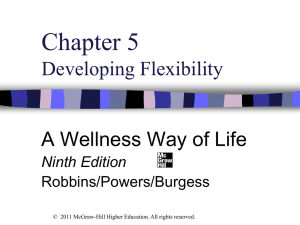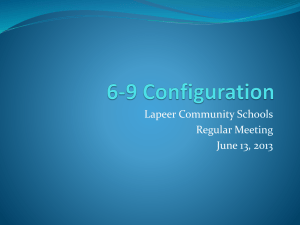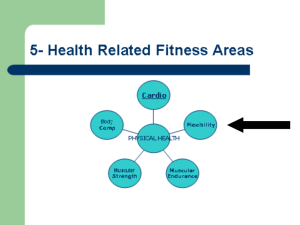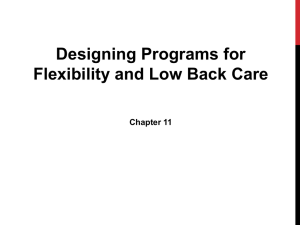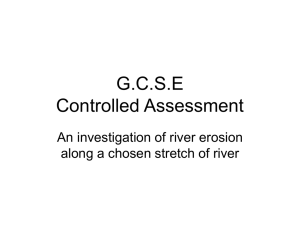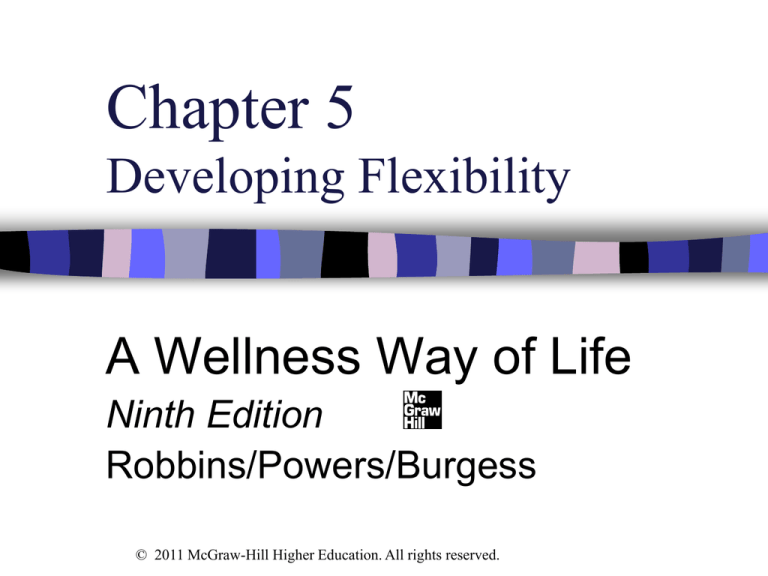
Chapter 5
Developing Flexibility
A Wellness Way of Life
Ninth Edition
Robbins/Powers/Burgess
© 2011 McGraw-Hill Higher Education. All rights reserved.
Chapter 5 Objectives
After reading this chapter, you will be able to:
1. Identify benefits of and five cautions for stretching.
2. Identify factors affecting flexibility.
3. Define two types of flexibility.
4. Identify four types of stretching.
5. Identify guidelines for flexibility development.
6. Define five principles of flexibility development.
7. List five flexibility exercises for basic fitness.
8. Differentiate between safe and contraindicated exercises.
9. Identify general guidelines for identifying exercises which
increase risk of injury.
10. Explain how flexibility and muscular fitness contribute to
wellness.
© 2011 McGraw-Hill Higher Education. All rights reserved.
Flexibility
The ability of a joint to move freely
through its full range of motion.
Flexibility tends to decrease with age,
disuse, injury, excessive body fat, and
muscle imbalances.
© 2011 McGraw-Hill Higher Education. All rights reserved.
Benefits of Flexibility
Decreased aches and pains.
Enhanced ability to move freely and easily.
Possible decreased risk of injury.
Recovery from injury.
Enhanced athletic performance.
Reversal of age-related decline in flexibility.
Improved posture and appearance.
Decreased muscle soreness after exercise.
It feels good.
© 2011 McGraw-Hill Higher Education. All rights reserved.
Factors Affecting Flexibility
Joint Structure
Soft Tissues
Inactivity
Muscle Temperature
Increased Age
Genetics
Gender
Obesity
Injury and Scar Tissue
Neural Factors
© 2011 McGraw-Hill Higher Education. All rights reserved.
Types of Flexibility
Static
– Range of motion that is achieved through slow
controlled stretching.
– Most commonly used and recommended type.
Dynamic
– Range of motion that is achieved through moving
a limb to its limits in a ballistic fashion.
– Associated with increased muscle soreness and
the stretch reflex.
– Used more in athletic competition. Not
recommended for personal fitness programs due
to risk of injury.
© 2011 McGraw-Hill Higher Education. All rights reserved.
Active vs. Passive
Active stretching uses your own muscle
forces to stretch yourself.
Passive stretching uses someone or
something else to assist with a stretch
(body weight, gravity, strap or leverage).
© 2011 McGraw-Hill Higher Education. All rights reserved.
Guidelines of Flexibility
Development
Frequency – 2 to 3 days a week (up to 7 days if
possible).
Intensity – slightly beyond the normal range of motion
to the point of tension.
Time – 10 to 30 second static hold.
Repetitions – at least 4 sustained stretches for each
muscle group.
Guidelines – warm-up first, stretch to prepare for
activity, cool-down stretch is most beneficial, stop at
the point of discomfort, DON’T bounce, strive for
muscular balance.
© 2011 McGraw-Hill Higher Education. All rights reserved.
Principles for Flexibility
Development
Progressive overload
– Improvement in joint range of motion occurs when sustained
stretching produces elastic and plastic elongation.
Specificity
– Flexibility is specific to each joint, i.e., an individual could do
the splits but have poor shoulder range of motion.
Reversibility
– If a persons stops stretching, over time, range of motion will
decrease.
Balance
– Muscles can be tighter on one side of the body. Pay
attention to flexibility differences and work to improve them.
© 2011 McGraw-Hill Higher Education. All rights reserved.
Tips for Developing Flexibility
Warm up before stretching
After warm-up, stretch to prepare for activity
Stretch for flexibility during cool-down
Stop at the point of tension, not pain
Stretch slowly and evenly
Try to consciously relax
Maintain regular breathing
Don’t bounce
Incorporate 8-12 stretches into your program
Strive for muscle balance.
© 2011 McGraw-Hill Higher Education. All rights reserved.
Common Flexibility Exercises
Hamstring stretch
Lower back/hip flexor stretch
Spinal twist
Quadriceps stretch
Calf/Achilles stretch
Iliotibial band stretch
Deltoid stretch
Pectoral stretch
Triceps stretch
© 2011 McGraw-Hill Higher Education. All rights reserved.
Flexibility Exercises
Figure 5-1
© 2011 McGraw-Hill Higher Education. All rights reserved.
PNF Partner-Assisted Stretches
Proprioceptive neuromuscular facilitation (PNF)
uses the nervous and muscular systems to
facilitate stretching.
PNF utilizes the inverse stretch relax to relax the
target muscle.
PNF stretch: perform a 10-30 second static
stretch, then contract the muscle for 6 seconds to
produce fatigue, and then relax while a partner
stretches your limb for 10-30 seconds.
For safety be sensitive to your partner’s needs
and flexibility level.
© 2011 McGraw-Hill Higher Education. All rights reserved.
Contraindicated Exercises
Do not hyperflex or hyperextend the knee, neck, or lower
back.
Do not twist the knee.
Avoid holding your breath.
Avoid stretching long weak muscles (abdominals) and
shortening short/strong muscles (hip flexors).
Avoid stretching to the point of pain.
Be especially careful when using passive stretches with
another person.
Avoid movements that place acute compressional force on
spinal discs.
Avoid movements that cause joint impingements or cartilage
damage.
If your sport requires the violation of good mechanics make
certain the muscles are as strong as possible.
© 2011 McGraw-Hill Higher Education. All rights reserved.
Exercises to Avoid
Avoid the following exercises:
Yoga plow, knee tuck to chest, head roll, hurdler stretch,
full squat, standing toe touch, ballet bar leg stretch,
windmill toe touches, straight-leg sit-up, double-leg lift,
swan arch, donkey kicks
Do the following:
Single-knee tuck to chest (hugging thigh), half-head rolls,
alternative hurdler stretch, half-knee bend, lying hamstring
stretch, sitting hamstring stretch, oblique abdominal curls,
bent-knee ab curls, single arm/leg raises, modified donkey
kicks.
There are some exceptions to these guidelines for those
who are well conditioned and can minimize risk.
© 2011 McGraw-Hill Higher Education. All rights reserved.
Rx for Flexibility
2-3 days per week
Stretch slightly beyond the normal range of motion
Repeat each exercise at least 3-4 times and hold for
at least 10-30 seconds
Static stretches to include every major joint of the
body (8 to 12 stretches)
© 2011 McGraw-Hill Higher Education. All rights reserved.
Rx for Action
While studying or reading the morning paper, sit on
the floor and stretch hamstrings.
While on the phone, do calf and quadriceps
stretches.
If you have a desk job, take a 5-minute stretch
break every hour – do ankle circles, half-head rolls,
and shoulder stretches.
After every hour of computer use, stretch wrists,
back, and shoulders.
While watching TV, stretch during commercials.
© 2011 McGraw-Hill Higher Education. All rights reserved.
What Do You Think?
Which of the factors affecting flexibility best
apply to you?
Which of the benefits of flexibility are most
important to you?
How important is stretching to your training
program?
Do you stretch before and/or after physical
activity? If not, why not?
What safe flexibility exercises are you willing
to perform?
© 2011 McGraw-Hill Higher Education. All rights reserved.
Questions?
© 2011 McGraw-Hill Higher Education. All rights reserved.


